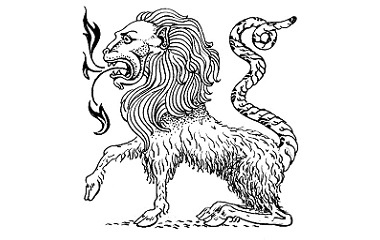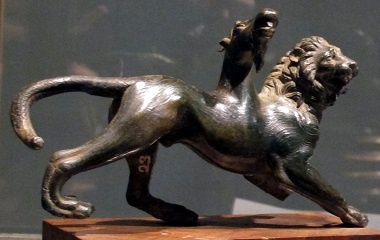What Is a Chimera?
A Chimera is a Greek monster with traits of the lion, the goat, and the serpent. This strange and terrifying creature was once thought to be invincible, but its reign of terror eventually came to a gruesome end.
Characteristics
Physical Description
The Chimera may be ancient Greece’s most bizarre creature—so bizarre that its name is now used to describe any creature with an unusual combination of animal traits.
At its most basic level, the Chimera is a female lion. It has a lion’s body, complete from head to tail. Exaggerated ears and breasts show that the creature is female, even though it does have a short, ragged mane.
But of course, there’s more to the Chimera than its lion features. The creature also has a goat’s head, rising from between its shoulder blades. The goat’s head appears to be male, since it has horns and a beard. Finally, the monster’s lion tail morphs into a snake, with a venomous serpentine head replacing the lion’s natural puff of fur.
Personality
Like most chimeric creatures in Greek mythology, the Chimera was a nasty piece of work. She had a terrible temper and no civilized instincts. She ransacked many villages, mostly killing cattle but sometimes destroying houses and slaughtering innocent people as well.
Special Abilities
The Chimera was reputed to be “near invincible,” for she had the strength of a lion, the cunning of a goat, and the venom of a snake. But this monster’s most unusual and deadly weapon, by far, was her ability to breathe fire. The fire spewed out from the goat’s head and devastated any challengers who approached the beast.
The Chimera was also seen as an omen, of sorts. She often appeared before natural disasters, mostly volcanic eruptions.
Legends of the Chimera
Parents
The Chimera was one of the offspring of a legendary pairing: Typhon and Echidna.
Typhon, the father, was an ancient and monstrous giant who was believed to be the most dangerous creature in all of Greece. For a mate, he took the next most monstrous creature in Greece, a half-woman, half-serpent named Echidna.
Together, Typhon and Echidna spawned many of the most dangerous beasts in Greece, including the Lynean Hydra, the Sphinx, the Nemean Lion, Cerberus, and, of course, the Chimera.
Battle with Bellerophon
For years, the Chimera roamed the Lynean countryside unchallenged, since “not even a quantity of men could subdue it with ease, let alone one.” But her legend didn’t take the hero Bellerophon into account.
Bellerophon was a son of Poseidon and a beautiful mortal woman. When he was young, he committed a crime and was sent to King Proteus to be punished. Proteus saw huge potential in the boy, and he decided to pardon his crime. Unfortunately, Proteus’s wife also saw potential in Bellerophon. She begged him to become her lover, and when he refused, she accused him of raping her.
King Proteus was outraged, but knowing that immortal blood ran in Bellerophon’s veins, he was afraid to punish the boy. Instead, he sent him to his father-in-law, King Iobates, who devised a clever way to get rid of the young offender. He challenged Bellerophon to kill the Chimera, fully expecting that the Chimera would kill Bellerophon instead.
But Iobates didn’t know that Bellerophon has a secret ally. Pegasus, the mighty winged horse, was Bellerophon’s half-brother, and the two of them had spent many happy days together in their childhood. Now, the young hero summoned Pegasus to his aid, and the two of them launched an aerial attack on the Chimera. Bellerophon rained arrows down on her, giving her several critical wounds. At last, he took a lead spear and hurled it into the creature’s fiery throat. There, the lead melted and spread throughout her body, burning her from the inside out.
Cultural Representation
Origin
The Chimera comes from ancient Greek mythology, appearing in paintings as early as the 6th century BC and in texts as early as the 8th century BC. Greek’s finest scholars, including Pliny the Elder, Seneca, Cicero, Virgil, Ovid, Homer, Plato, Pindar, Hesiod, all contributed to the monster’s legend.
Three thousand years before the ancient Greek Chimera appeared, the Egyptians worshipped a sun goddess named Sekhmet, who sometimes appeared as a fire-breathing lion. It’s possible that Sekhmet’s legend inspired the Chimera.
Modern Appearances
Today, the word “chimera” can be used to describe any creature with a strange combination of animal parts. However, the classic lion-goat-serpent Chimera still has a place in fantasy and sci-fi. Franchises like Yu-Gi-Oh, Wrath of the Titans, Percy Dragon, American Dragon, Final Fantasy, and World of Warcraft have all used the Chimera to test their heroes.
Chimera






No comments:
Post a Comment